|
Rincon-Vitova Insectaries, Inc. is the world’s
oldest free enterprise insectary. We have a mission to
promote the use of natural enemies as a more
effective means of pest control than toxic
pesticides. The success of thousands of
practitioners is a testimony to our know-how and the
guidance of our founding president Everett J. "Deke"
Dietrick.
We keep learning about new resources we want to
share. If you have a question, a topic to suggest or
a new technique to contribute, email it to
bugnet@rinconvitova.com.
|
Adapt Beneficial Releases to Site
|
|
With knowledge and observation of insect behavior, you can adapt releases to any situation
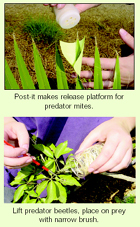
Take Cryptolaemus, the Mealybug
Destroying Ladybug, for example. It is attracted to
light and white
clothing, releasing at night and wearing dark
clothing makes it more likely that they will settle
down. Use a small brush to place individuals on infested
foliage. A spritz of watered down honey or our
Insect Food on foliage should help them feel at
home. Predatory mites benefit from a release station
to colonize most foliage. Divide mites into small
envelopes and staple to inner leaves. Post-it notes
folded over small twigs can give beneficials a
release platform in the foliage.
|
|
Predator Spotlight
|
|
A Reunion of Lindorus with Its Name
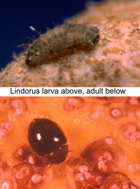
Lindorus lopanthae is a black beetle with an orange
colored head and thorax. Brought from Australia in
the 1890’s to control purple scale in citrus, adults
are 2.5 mm long. A few years ago the University
suggested we call it Rhyzobius and we went along
even though most people in the field call it
Lindorus. We recently hosted an entomologist from
Australia who said it IS Lindorus. He should know
since this ladybug hails from down under. We like
calling it Lindorus again! (There is also a
Rhyzobius that looks like Lindorus, but is not
associated with California citrus red scale where we
find our Lindorus.)
Lindorus lays eggs under armored scale covers and
the developing larvae eat the scale. They move on to
attack many more scale and are active at
temperatures as low as 40° F and as high as 100° F.
Honeydew from mature soft sticky scale is a barrier
but Lindorus will eat the eggs and crawlers of soft
as well as hard scale. Ten adult beetles per
infested tree form a colony that will hit dense
patches of hard scale. They are hard to find except
for the distinctive way the scale is ripped apart.
Good results have come from release programs for
scale in pine trees, cycads, as well as various
scale on indoor plants. Scale infestations are often
caused by ant interference.
|
|
Insects -- A Public Relations Challenge or Asset
|
|
Successful Practitioners Have a Knack for Biology
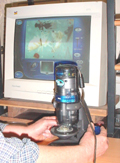
Professionals using Rincon-Vitova beneficials in
public gardens are dedicated naturalists, with a
strong desire to apply insect ecology and an
enthusiasm for learning. Moody Gardens and
Shangri-La were under biological programs when they
opened. San Francisco International Airport and
Dallas World Aquarium are newcomers while Foxwoods
resort, Callaway Gardens' Butterfly Center, and
North Carolina Zoological Park have had biological
programs with us for many years. Among the many
unique horticultural environments where biocontrol
is being practiced are the decorative plantscapes in
buildings, shopping malls, conservatories and other
public spaces.
These horticulturists are avid learners about the
flora and fauna they are managing. It sometimes takes a
little effort to find help to identify pests. One
fun tool is the Intel Play QX5 child’s digital
microscope
(developed with Mattel and sold for $80 at
www.playdigitalblue.com). Its
digital photos can be
emailed to entomologists or collaborators.
In public gardens and conservatories that promote a
biological program in their public education it is
easy to explain release cards and and other exposed
materials . In offices and restaurants, on the
other hand, managers often want to be low-profile
even though materials and beneficials are not
generally noticeable. Where suitable, an initial
release of large numbers of beneficials to colonize
the plantscape is followed up with monitoring and a
number of smaller releases, as needed, to ensure
long-term establishment of natural enemies. Most
successful maintenance
programs continue year round with very small
preventative releases every two to four weeks.
Whether discreet or didactic, visitors appreciate
plantscapes managed with fewer chemicals.
The benefits of a biological control approach are
that plants live longer and need replacement less
often when not weakened by chemicals. Employees are
happier and
liability risks are reduced. As if this were not
enough, there are also valuable public relations
benefits from using this new "green" environmentally
friendly technology.
|
|
BioStart Microbials are Back
|
|
Streamlined Formulations with Microbe Food
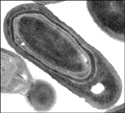
Rincon-Vitova is pleased to announce that BioStart
Rhizoboost and Defensor, shelf stable soil
inoculants, are in stock at our facility in Ventura.
Here is Bacillus subtilis, one of the two microbes
in Defensor.
BioStart Rhizoboost contains naturally occurring,
beneficial microorganisms that increase biodiversity
in the soil. At one quart/acre through the
irrigation system it provides 250 billion viable
microorganisms into the root zone. For best results,
make four applications 7-10 days apart with food.
Rhizoboost bacteria produce natural plant growth
hormones (auxins, gibberellins and cytokinins). The
mix of Bacillus licheniformis, B. laterosporus, and
B. chitinosporous is associated with increased crop
yields. The benefit is dramatic in fumigated or
depleted soil. B. chitinosporous feeds on disease
organisms. We see more root mass and fine root hairs
and reduced nematode and disease problems.
The companion bacterial inoculant product, Biostart
Defensor with Bacillus subtilis and Bacillus cereus
is strongly antagonistic to plant disease. We and
a local Master Gardener eliminated powdery
mildew on our roses, which is common with our coastal
humidity. Our zucchini also looked like it might
succomb to powdery mildew. We arrested it with one
Defensor spray. We lost many leaves, but the new
growth is staying clean! The kale we sprayed is also
clean, but the sorrel didn't get sprayed and is now
covered with mildew. The productivity of this one
squash plant is also
a phenomenal testimony to our enhanced soil ecology.
It helps to wash mildew off before spraying with
fungi-eating bacteria. A spray wash with 1 T baking
soda and 1 T dishwashing liquid in a gallon of water
may be enough (test on leaves first), but a
follow-up bacterial spray or drench will be more
protective. Defensor also suppresses botrytis and
other diseases by competing with pathogenic fungi.
Always apply Rhizoboost and Defensor separately
from each other, but include some food with bacterial
inoculants. We put together an
inexpensive mix we call Microbe Nutrients, made of
dried molasses, dextrose, yeast and humic acid that
dissolves in water to flow through sprayer and
irrigation equipment. You can just add sugar or,
better, liquid molasses. Biocontrol at the root zone
is the foundation for successful plant protection.
|
|
Controlling Mealybug in Protected Settings
|
|
Crypts, Lacewing and Leps Play Roles in Different Scenarios
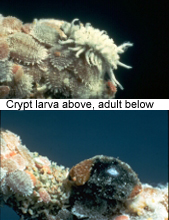
The most common species of mealybug in interiors and
ornamental production is citrus mealybug. Other
species are long-tailed, obscure, citrophilus, grape
and root mealybug. They suck the sap, damaging
foliage and produce honeydew, which supports the
growth of unsightly mold on leaves, and draws ants.
Inspect new growth and look for ants. Even a single
larva or a scale tended by just a few ants is a
potential hotspot of mealybug all along the ant
trail.
Biological Controls
Mealybug Destroyer: The lady beetle
Cryptolaemus montrouzieri is effective when mealybug
numbers are high and conditions are warm and humid
and days longer. Several releases may be necessary,
particularly during winter. "Crypts" may be drawn to
a strong light from a skylight or picture window. In
such situations, release after dark so the beetles
find food and get settled before the bright sun
attracts them to the window. They are less effective
on longtailed mealybug (Pseudococcus longispinus).
Crypt larvae are covered with white waxy hairs and
look like mealybug.
Green Lacewing: Lacewing larvae eat mealybug
of all
species, especially long-tailed mealybug that are
more widely distributed on plants. Being retiring,
they are the predator of choice where you do not
want the public to notice Crypts or where there is a
bright light attracting Crypts away from foliage.
Lacewing search well and waste no time killing their
prey. Don’t assume that the remains of a lacewing
feast are alive! Mealybug exoskeletons are left
behind and may need to be blown off of decorative
plants. Lacewing eggs glued on cards are hung in
foliage, every week or two. At least four steady
releases are needed or until monitoring shows no
more pests. Green lacewing larvae in paper
honeycombs work faster because they are ready to
feed on larger prey. Lacewing also eat aphid,
whitefly, scale, caterpillars, spider mite and more.
Leptomastix:  The tiny wasp Leptomastix dactylopii lays her eggs
in citrus mealybug nymphs and adults. She
complements Cryptolaemus use for citrus mealybug.
Correct
pest identification is useful. Crypts or lacewing
should be released to reduce mealybug, followed by
Leptomastix, for thorough low density control. They
prefer warm sunny humid environments.
The tiny wasp Leptomastix dactylopii lays her eggs
in citrus mealybug nymphs and adults. She
complements Cryptolaemus use for citrus mealybug.
Correct
pest identification is useful. Crypts or lacewing
should be released to reduce mealybug, followed by
Leptomastix, for thorough low density control. They
prefer warm sunny humid environments.
Pathogen: Safe sprays made with the fungus
Beauvaria
bassiana, such as Botanigard, Mycotrol, or
Naturalis, will reduce the population before release
of beneficials.
Root Mealybug: Drench soil with beneficial
nematodes
such as Heterorhabditis indica, a Beauveria product
(Botanigard), chitin digesting bacteria
(Rhizoboost), or an essential oil product (GC3).
Other Measures
• Prune heavily infested branches.
• There are many safe baits to control ants, which
protect mealybug from predators.
• Spot-treat with insecticidal soap. Clean
houseplants with Dr. Bronner's soap mixed with Hot
Pepper Wax and rubbing alcohol. Avoid broad-spectrum
toxic pesticides.
• Quarantine new plants or severely infested plants
when possible.
• Sometimes just moving indoor plants outdoors will
eliminate mealybug and similar pests.
|
|
Practitioner Spotlight
|
|
Inaba Vegetables Host Beneficials

Inaba Produce Farms has used sustainable practices
since the original Inaba brothers came from Japan to
Yakima Valley three generations ago. Beneficial
releases are part of their current pest management
program. One of the biggest challenges on the farm
right now is the asparagus aphid—hard to treat in a
40 acre forest of 6 foot tall ferns. Lon Inaba is a
good observer of nature on the farm. He comments,
"If it had an easy solution more people would be
trying to produce it, the challenges to figure out
what’s going on keep us from getting bored."
Innovators like Lon collaborate with researchers to
develop organic methods to solve pest problems.
Here are Lon and his mother, Shiz, on a brief break
from packing onions at the shed. Shiz at 75+ is
still working 10+ hour days! That must be what keeps
her so young.
|
|
Friend Max Badgley -- 1922-2006
|
|
Took Many Insect Photos For Us

Many of our treasured images of pests, predators and
parasites (including the Cryptolaemus in this
newsletter) are a legacy of former Rincon-Vitova
employee, Max Badgley. In the 1960’s Max was on the
team that developed mass-production systems for
green lacewing and fly parasites. It was a pleasure
to know and work with him. This photo of Max in his
lab at UCR
in 1969 was sent by his daughter, Linda Scott, also
for a time employed with RVI. Max's son Mark is
working on scanning photos for a website. Max's
skill and spirit of service in capturing insects on
film are warmly remembered.
|
|
Hot Link
|
|
http://ipm.ucdavis.edu/PCA/pestid.html
For pest identification with great pictures, “PCA
Exam Helper” at the UC-IPM Online Educational
Resource is in a class by itself. Recommendations
for using beneficials are sometimes under-whelming.
However, for online help to get to know the pest and
potential natural enemies this site is a boost for
problem solving with biocontrol. Find the same
outstanding quality in UC-IPM’s print publications.
|
|
Hot Pub
|
|
Among Reference Books— An Old Treasure

When we’re looking up a pest, the first reach is
often to E. O. Essig’s “Insects of Western North
America”, 1926, “A Manual and Textbook for Students
in Colleges and Universities and a Handbook for
County, State and Federal Entomologists and
Agriculturists, as well as for Foresters, Farmers,
Gardeners, Travelers, and Lovers of Nature.” Used
copies sell for under $20 Insect identification
resources are often regional. We are interested in
where you turn for insect identification.
|
|
|